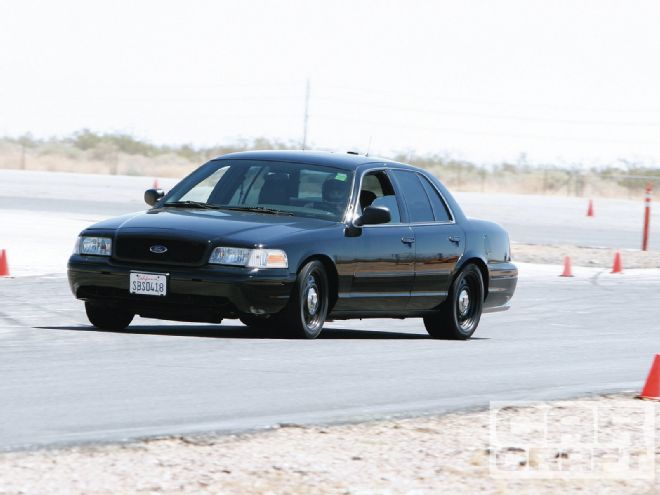
Way back in our Aug. '11 issue, we ran an article titled "Coilovers for the Coppers," in which I gave you the lowdown on installing coilover shocks and an Addco sway bar on the front of my '03 Crown Victoria Police Interceptor. I also glossed over the installation of a pair of Eaton Detroit 1-inch lowering springs in the rear. At the time, my main goal was just to lower the car. It was too tall, even for a stock vehicle. I realize police cars are made to jump curbs in the pursuit of perps, but my car looked like it could leap small buildings. This time around, I had the time to finesse the setup, and in the process I learned some valuable lessons that apply to any car, not just late-model, fullsize Fords. So don't turn the page in disgust at the sight of a four-door sedan. There's good info here.
Not Quite Right?
Talk to different engineers and suspension builders and each one will have a preferred method of setting up a car. Generally, there are two camps: stiff springs/soft shocks/small sway bars versus soft springs/stiff shocks/big sway bars. If there is a universal constant, it is that the spring rate must increase, however slightly, when lowering a car, simply because the suspension physically has less room to pivot.
Which theory is right? Neither. The answer partly depends on the handling characteristics you desire for your car. Dedicated autocross cars will generally have a stiffer spring rate than one destined for track-day driving, where a slightly softer spring rate will allow more weight transfer under cornering and braking loads. Performance street cars fall somewhere in between.
Ultimately, the correct answer depends on what is most comfortable for your driving style. Before buying the Crown Victoria, I was used to driving a car more stiffly sprung. After installing the new springs, the car didn't feel right, not because the spring rates were necessarily wrong for the application but because the characteristics of the ride didn't change as much as I anticipated they would.
Spring Rate Comparison
'03 to '07 Crown Victoria Police Interceptor
Stock
Eaton Detroit 1-1/2-lower
Naake/QA1
Front
Rear
Front
Rear
Front
Rate (in/lb)
330
163
355
172
450
N/A
What I Should Have Done
I could have saved some of the hassle by following the guide outlined to me by QA1's tech support staff. This method works with any car and helps determine custom springs and shocks for custom applications, race cars, or cars that don't have broad aftermarket support. Also, don't take this as blatant QA1 product placement. This method will generate the measurements any suspension company will need to know before they can sell you anything.
The Bottom Line
I'd been hoping all this work would translate into better performance. The folks at our sister publication Motor Trend agreed to run my car through their standard battery of tests, and I was pleased to see how my car compared with a stock police package Crown Vic they tested two years ago.
Stock '07 Crown Victoria Police Interceptor CC's '03 Project Panther 0-60 7.8 seconds 6.0 seconds Quarter-mile 15.9 at 88.1 mph 14.5 at 97.8 mph Braking 60-0 135 feet 126 feet Skidpad 0.80 g 0.86 g Figure-8 lap time 28.9 sec at 0.58 average g 26.6 sec at 0.68 average g
Parts List
Description
Pn
Source
Price
Double-adjustable front kit
NA-MMFTDA
Naake Suspension
$795.00
Pro-Kit 1-inch lowering springs, front
3596120
Eibach
$165.73
1-1/2-inch lowering springs, front, Police/Taxi
MC5412-11/2
Eaton Detroit Spring
$189.95
1-1/2-inch lowering springs, rear, Police/Taxi
MC3895-11/2
Eaton Detroit Spring
$189.95
12-inch heavy-duty combination square
67770
Harbor Freight Tools
$7.99